Paul Murrell tests the 2019 Hyundai Ioniq EV with pricing, specs, ride and handling, safety, verdict and everything the over-50 driver needs to know.
Summary: Electric vehicles have been limited to niche markets for way too long. The new Hyundai Ioniq EV will widen the appeal, but until word gets around, it will be fleets, governments and councils who will be the early buyers.
2019 Hyundai Ioniq EV
Pricing: From $44,990 (plus ORC) (this price makes EVs accessible to almost everyone)
Warranty: Five-years, unlimited km (but the battery is covered for a generous eight years or 160,000km)
Safety: not yet ANCAP tested
Engine: permanent magnet synchronous electric motor (yes, we had to do some research too)
Power: 88kW
Torque: 295Nm
Transmission: fixed single-speed
Drive: front-wheel drive
Body: 4470mm (long); 1821mm (wide); 1445mm (high)
Cargo area: 350 litres (very reasonable, although you’ll be carrying the plug and cord everywhere you go)
Towing: not allowed
Weight: 1420kg
Tyres: 205/55R16
Spare wheel: none
Turning circle: 11m
Battery: 28kWh
Energy consumption: 11.5kWh/100km
seniordriver consumption: 12.8kWh/100km
[review]
OKAY, SO MR SHORTEN wants 50 percent of all new car sales to be electric by 2030, meaning a lot more of us will be abandoning fossil fuels and taking up ownership of EVs, even if he doesn’t become prime minister.
Until now, electric vehicles have been a mere dot on the monthly new car sales figures, and high-priced choices such as the Tesla and Jaguar i-Pace are never going to appeal to a wide market (good though they are).
But Hyundai has chosen to launch a range of vehicles that have the potential to change the way we think about EVs (and hybrids, for that matter). In addition, Nissan will be re-launching the LEAF in coming months, so things may, finally, be about to change.
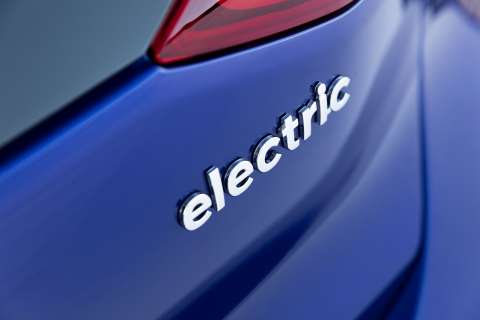
A model for any usage pattern.
Some time ago, we spent a week in the Ioniq Hybrid, so let’s clarify just what’s on offer. Hyundai is offering three variants: the Hybrid (starting from $33,990 plus ORC), a Plug-in Hybrid ($40,990 plus ORC) and the vehicle we’re talking about here, the all-electric model, with an entry price of $44,990.
There are two trim levels, Elite and Premium. Premium adds $5000 to the price of the Hybrids, but only $4000 to the electric model.
The Electric differs from the Hybrids by having a different nose (no need for a radiator, so no call for a grille!), a unique transmission tunnel, torsion beam rear suspension (replacing the Hybrid’s fully independent rear suspension), push-button electric shift and an electronic parking brake with auto hold (a huge improvement over the foot-operated parking brake in the others). It also has a slightly larger luggage area (350 litres as against 341 in the Plug-in).
The Ioniq is a similar size to the Mazda3 and Toyota Corolla – in other words, ideal for the average young Australian family. Front seat space is fine, as is legroom in the rear, but the rear seats will be a squeeze for three adults, and headroom is limited.
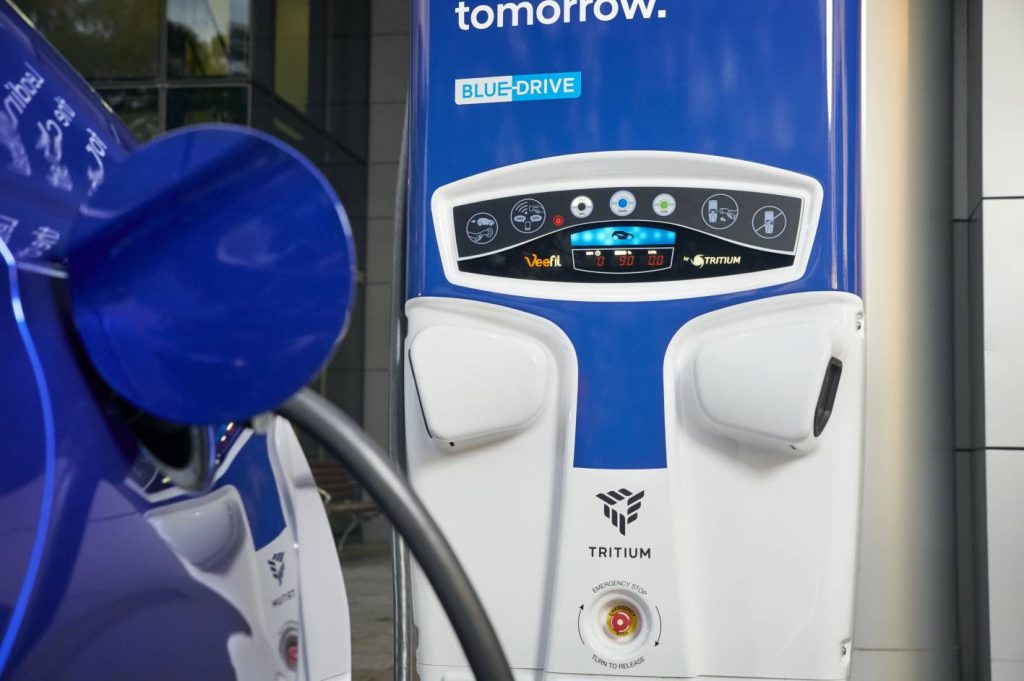
Finally, some usable range.
The Ioniq EV gets an 88kW/295Nm motor and a 28kWh battery. According to the NEDC test cycle, that means a range of 280km. According to Hyundai, a more realistic range is 230km, and we regularly saw a distance-to-recharge range (it shows a petrol pump-looking icon, but with a power plug coming out of it – cute!) of 250km. Turning on the air conditioner immediately drops that by 20-odd kilometres.
As with Hybrids, we still want them to be as “normal” to drive and operate as possible, and that means as close to a traditional petrol-engined car as it can be. The Ioniq EV does a good job of mimicking the cars you’re used to, although as with any electric vehicle, some techniques need modification.
Unlike some other EVs, you really can just get in and drive the Ioniq without constantly having to adapt. It takes off at the lights with more alacrity than you’re used to, especially compared to similar-sized economy cars with smallish petrol engines. Overtaking even at the legal speed limit doesn’t cause any nervousness and overall response is probably better than equivalent petrol-engined cars. Lifting off the throttle delivers battery regeneration, and this does take a little explanation. There are four levels of regeneration, from totally off through to the most aggressive, Level 3, as indicated on the dashboard. Flicking the steering-wheel mounted paddles moves you through the regeneration levels, providing progressively stronger levels of regeneration and retardation, just like a normal gearbox.
All too complicated? Then just turn the whole regeneration thing off and drive as normal.
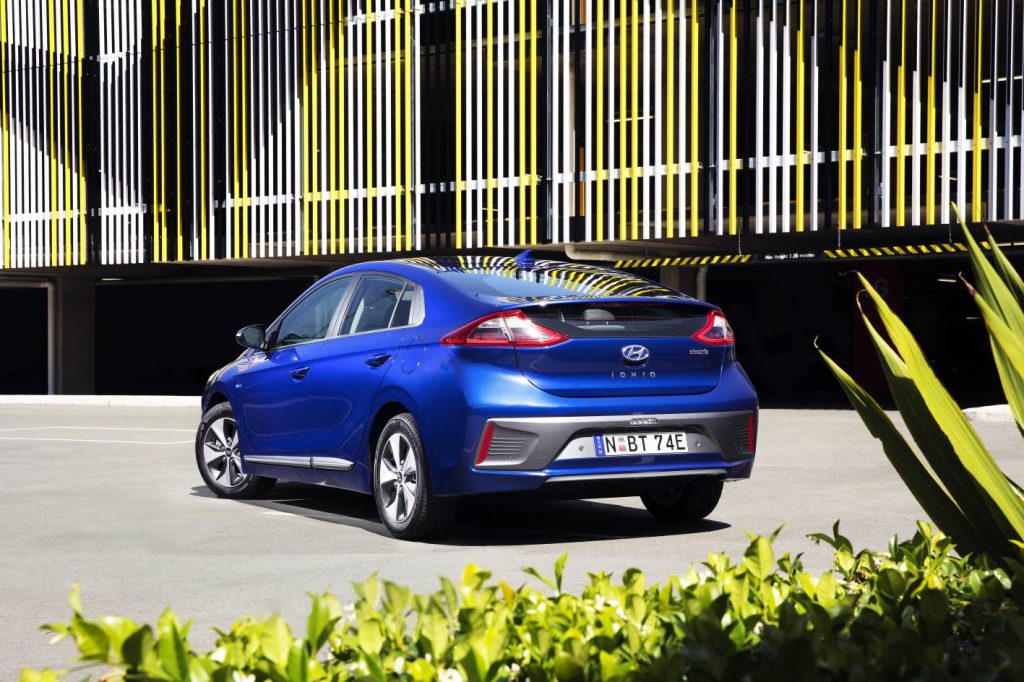
But can you relax?
One of the enduring concerns with EVs is range anxiety – where and when can I recharge before running out of battery power?
Talking about average distances travelled is all well and good, but even if the average daily car travel for Australians is 32 kilometres, there are plenty of occasions where we need to travel further than that. Fortunately, the range indicator in the Ioniq appears to be extremely accurate, so that’s one potential cause for concern taken care of.
On the other hand, in the car we drove (and it may have been improved with later software or updated sat nav), indicated recharging points were few and far between, and not particularly accurate or helpful. After all, when you’re an indicated 68 kilometres from the nearest suitable charging point, and your range is down to 40, you have a real problem. You could try knocking on someone’s door and asking if you could plug your car into their power point, but we doubt you’d get a warm welcome, and in any case, you’re looking at 12 hours to fully recharge using a household power outlet. A home Delta Charger unit (just under $2000 installed) reduces that to around 4.5 hours
Using a fast kerbside charger (and they are getting better – i.e. faster – all the time), we plugged the Ioniq in when it showed 40 percent charge and 78km distance to recharge. The onboard computer suggested a full charge would be achieved in two hours 50 minutes. When we returned one and a half hours later, the car was 60 percent charged with a 120km range (dropping to 107km when we switched on the air conditioning).
Using a 100kW fast charger, we are told the Ioniq can be charged from empty to 80 percent in 23 minutes. We were a little concerned that the owner’s handbook warned that using fast chargers (rather than trickle chargers) would shorten battery life, but the battery is guaranteed for eight years or 160,000km, so it shouldn’t be an issue.
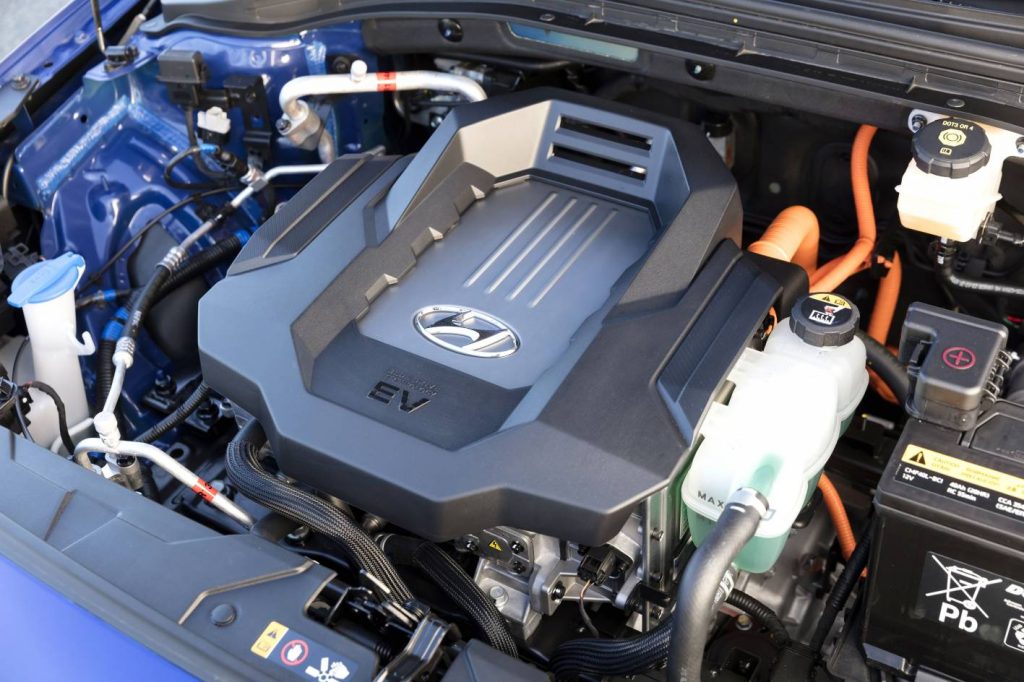
Found a charge point, but is it compatible?
Before collecting the Ioniq, we were relieved to see a charging point close to where we would be garaging it overnight, despite the sat nav suggesting the nearest charge point was 70-odd kilometres distant.
So far so good. Except that that plugs weren’t compatible so the charge point was as useless as a traditional petrol bowser for us. And it required us to have pre-registered so we could swipe a credit card before beginning charging. In the UK (and so, we presume, here as well), power plug adaptors are available that allow you to recharge at non-compliant charge points – the Hyundai appears to use a plug the same as Tesla.
Using a computer, we discovered a number of charge points nearby and one of them was a Tesla charge point, so we connected and recharged, without having to pay anything for the privilege. But as we mentioned earlier, the predicted recharge time was almost three hours, and even we can’t linger over a coffee for that long!
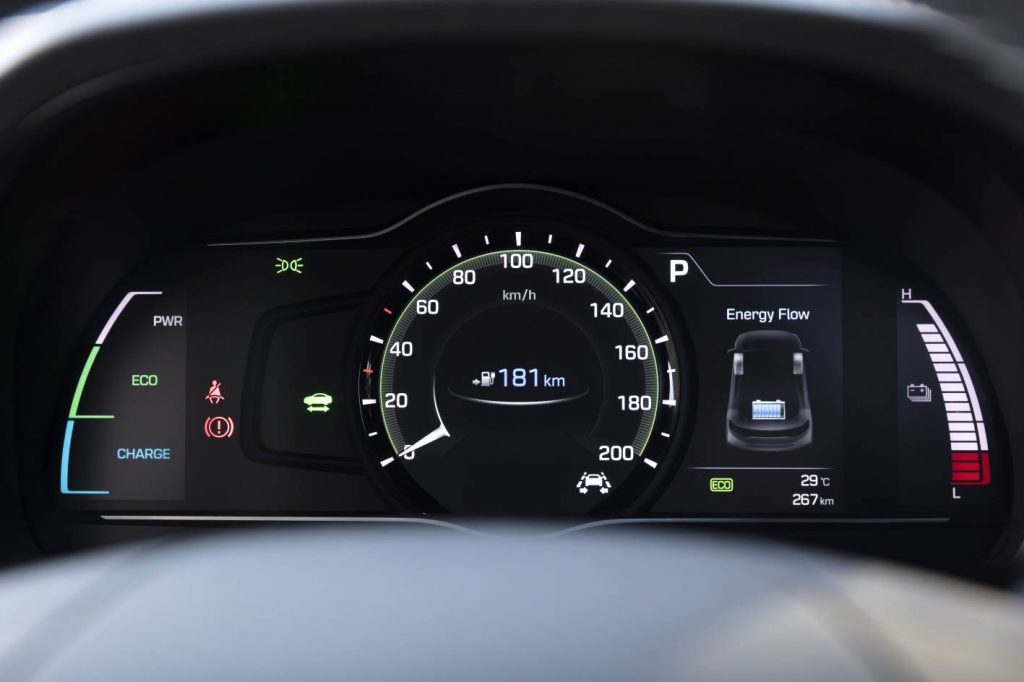
How far will you travel?
Obviously, electric cars are designed primarily for city use. However, not all of us can afford different vehicles for different applications, so it is a real factor for most buyers, even if long distance journeys are only occasional.
Our commute on the day we collected the Ioniq was about 80km after some around-town duty. At no point did we feel any anxiety about our range. Once we arrived at our overnight garage, we simply plugged the car into a standard household power point and left it to recharge overnight. Had we needed to repeat the same driving pattern the next day, the 230km range would have been more than adequate.
But as one interested observer delighted in pointing out to us, a Sydney to Melbourne run down the Hume Highway is 877km. That means you’d have to recharge four times to make the journey, and even if recharging time was half an hour (which, in our experience it certainly isn’t), that’s a major inconvenience. Even more of a consideration would be a journey from, say, Sydney to Broken Hill. That’s an 1100km trip and would require five recharges. But the odds of finding a suitable recharge point, when you need it, on that journey are tiny, and unlikely to substantially improve in the short term.
Of course, common sense would suggest that if you are contemplating a long trip, leave the Ioniq at home and take something more suitable, even if you have to hire it.
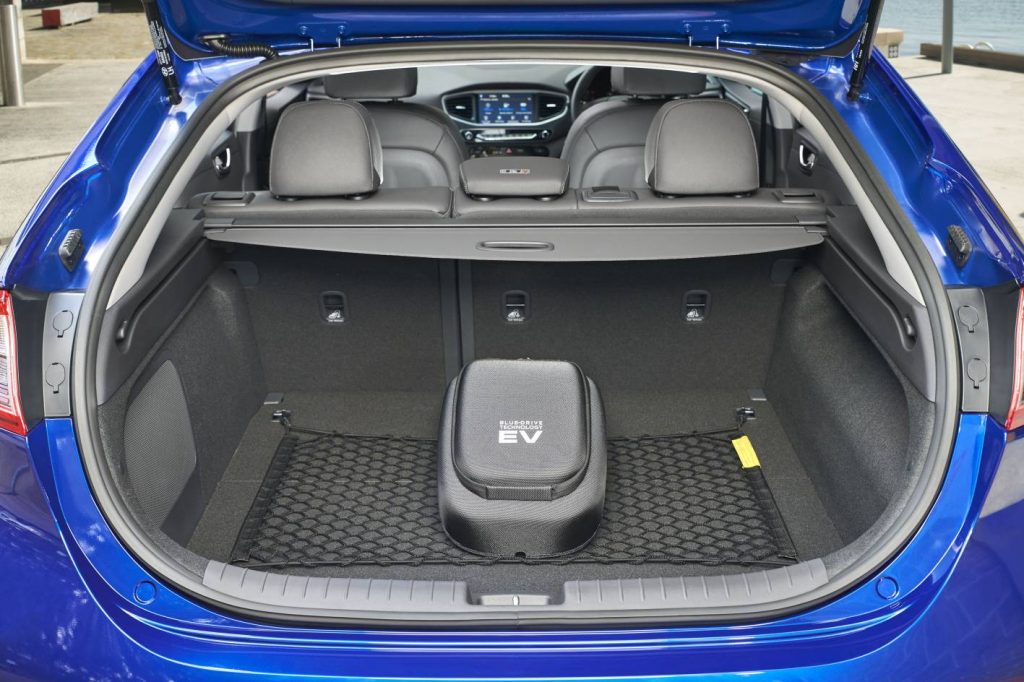
Smooth operator.
The Ioniq gets a fairly bland but not-unappealing fastback external design.
Underneath, a number of changes such as smooth underbody and front wheel air curtains, plus external enhancements including an integrated rear spoiler, sculpted sill mouldings and a functional diffuser result in a super-slippery drag co-efficient of just 0.24.
Recycled plastics, sugarcane by-products and powdered wood (sawdust to you and me) are used in the interior, making it a true ecologically-sound proposition (and no, you won’t feel like you should be wearing socks and sandals).
While hardly a luxury car, the Ioniq EV is well-equipped with auto headlights, LED daytime running lights and tail lights, alloy wheels, keyless entry and start, 8-inch colour multimedia touchscreen, reasonable quality sound system with Bluetooth, Apple CarPlay and Android Auto.
Of course, you expect an electric vehicle to be quiet, but the absence of engine noise usually highlights the road noise. The Ionic has been fitted with an acoustic laminated windscreen, special foam fillers in the A- and B-pillars and tailored floor panel sound insulation pads to bring the noise level down even further.
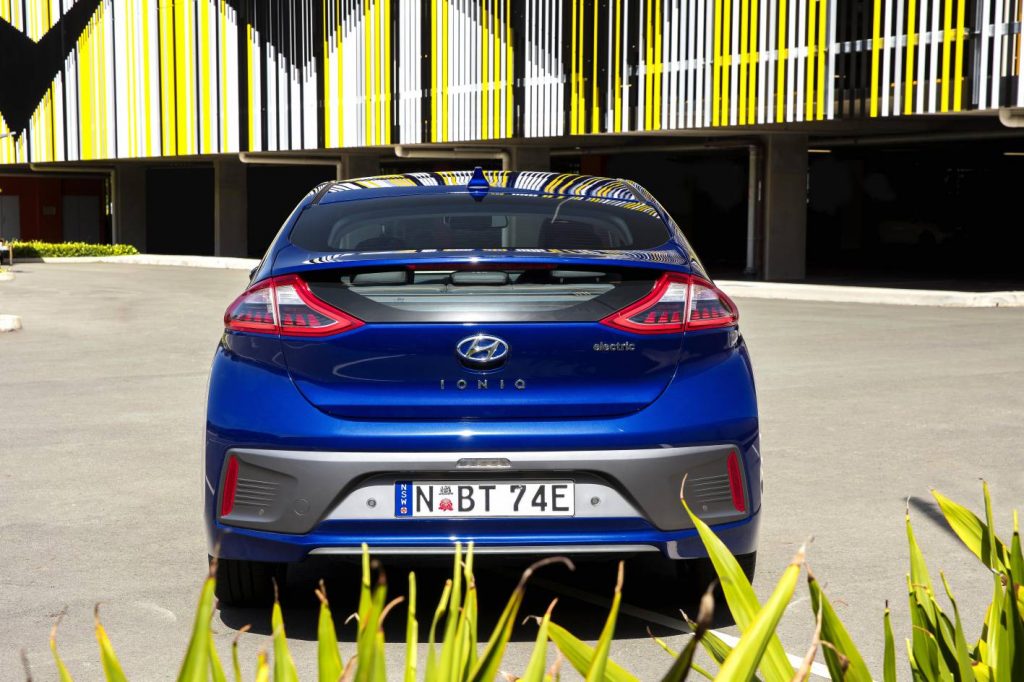
Who’s going to buy the Ioniq EV?
Hyundai is predicting that 50 percent of Ioniq sales will be for the EV. Certainly, in the early stages, byers will be governments, councils, large industry and big business, rather than private buyers.
Plans are afoot to kit out just 18 Hyundai dealers as “electric flagship” stores, a very small percentage of the total 170 dealers across Australia. Nissan faced a similar situation when it initially launched the LEAF, with dealers facing a hefty bill to set up to service and maintain the cars.
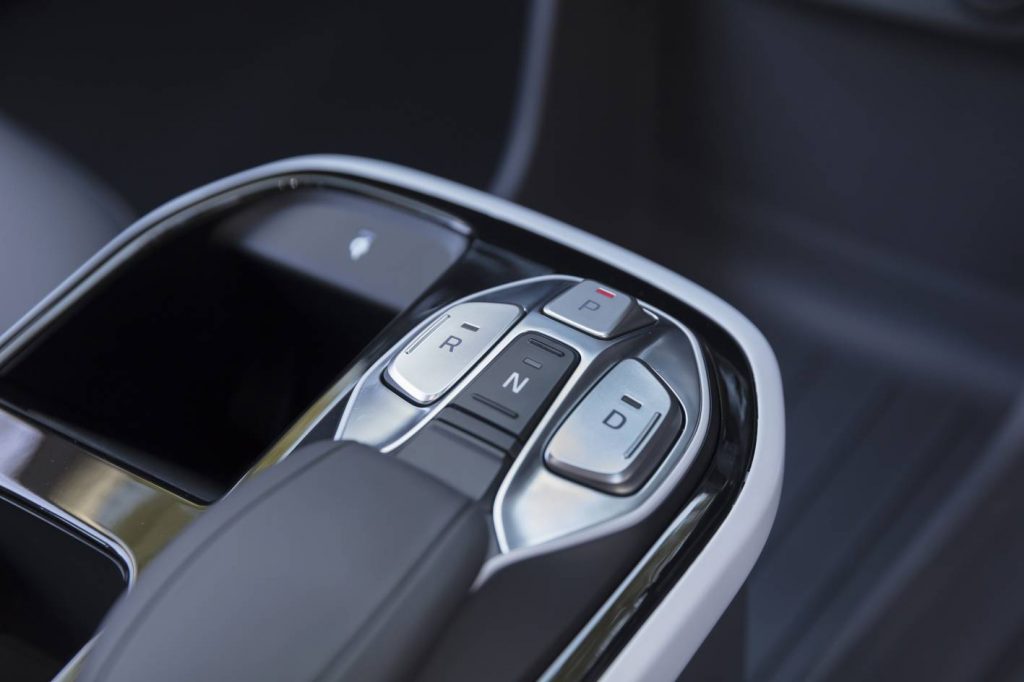
Niggles? We have a few.
While the whole idea of an EV is to reduce your weekly running costs, you can take it too far. Selecting Eco mode will add some kilometres to your range, but because it lops off the top 10 percent of the torque curve, things get mind-numbingly boring.
Another annoyance is the split back window. It creates a distracting obstruction to rear vision. And unlike, say, the Honda Civic hatchback, it’s higher up so it’s right in your line of sight.
And finally, for an electric vehicle, the absence of USB ports or 12-volt outlets in the rear seats is a strange oversight.
Another worry sorted.
Ioniq EV buyers will enjoy the same five year/unlimited kilometre warranty as applies to other vehicles in the Hyundai range (and according to some, Hyundai is now evaluating longer warranties, since five years has become the norm – Hyundai was first to launch a five year warranty way back in 1999, something that many luxury brands are still to adopt).
Safety is also at the high end. Hyundai’s ‘SmartSense’ safety suite is standard and includes useful features such as AEB and foward collision avoidance assist, blind spot monitoring, lane change assist, smart cruise control and cross traffic collision warning, emergency stop signal, plus, of course, ABS, EBD, BA, ESC and stability management. Also included are rear view camera and park assist, plus tyre pressure monitoring.
The first service (1500km) is complimentary. The battery warranty is for eight years or 160,000km. Service intervals are 12 months or 15,000km and the EV will cost $160 to service each year.
Summary.
Driving the Ioniq EV felt like the future had finally arrived. Most of the issues that bother people about EVs have been addressed, and now it’s just a matter of them making the leap and entering the electric age.
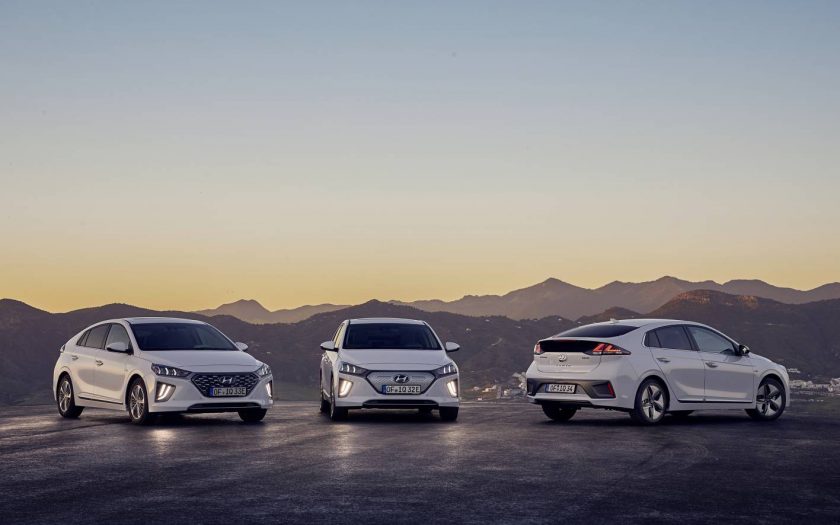
We had some interesting comments from a reader in WA wondering why better range can’t be part of the deal. Well, with the rapid advancement in batteries, it already is. The new Hyundai Kona has a 64kWh battery for a range of 450km, but these things don’t come cheap (explaining why the Kona EV is more than $60,000). He also asked about the cost of battery replacement, plus installation (something we’ll look into) and made the comment that replacing the battery in an eight-year old Ioniq may not be cost effective and that the replacement battery would probably outlive the car. He said, “either I am going to be forced to replace the batteries, at the likely going rate, and have them installed, or attempt to sell it off, knowing full well the car would be significantly devalued with battery replacement imminent”. Good points all, and we’ll investigate further.